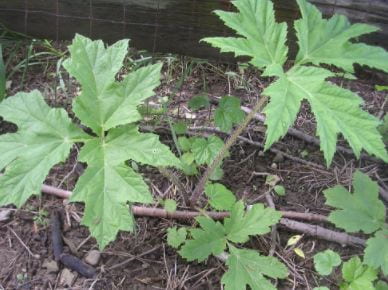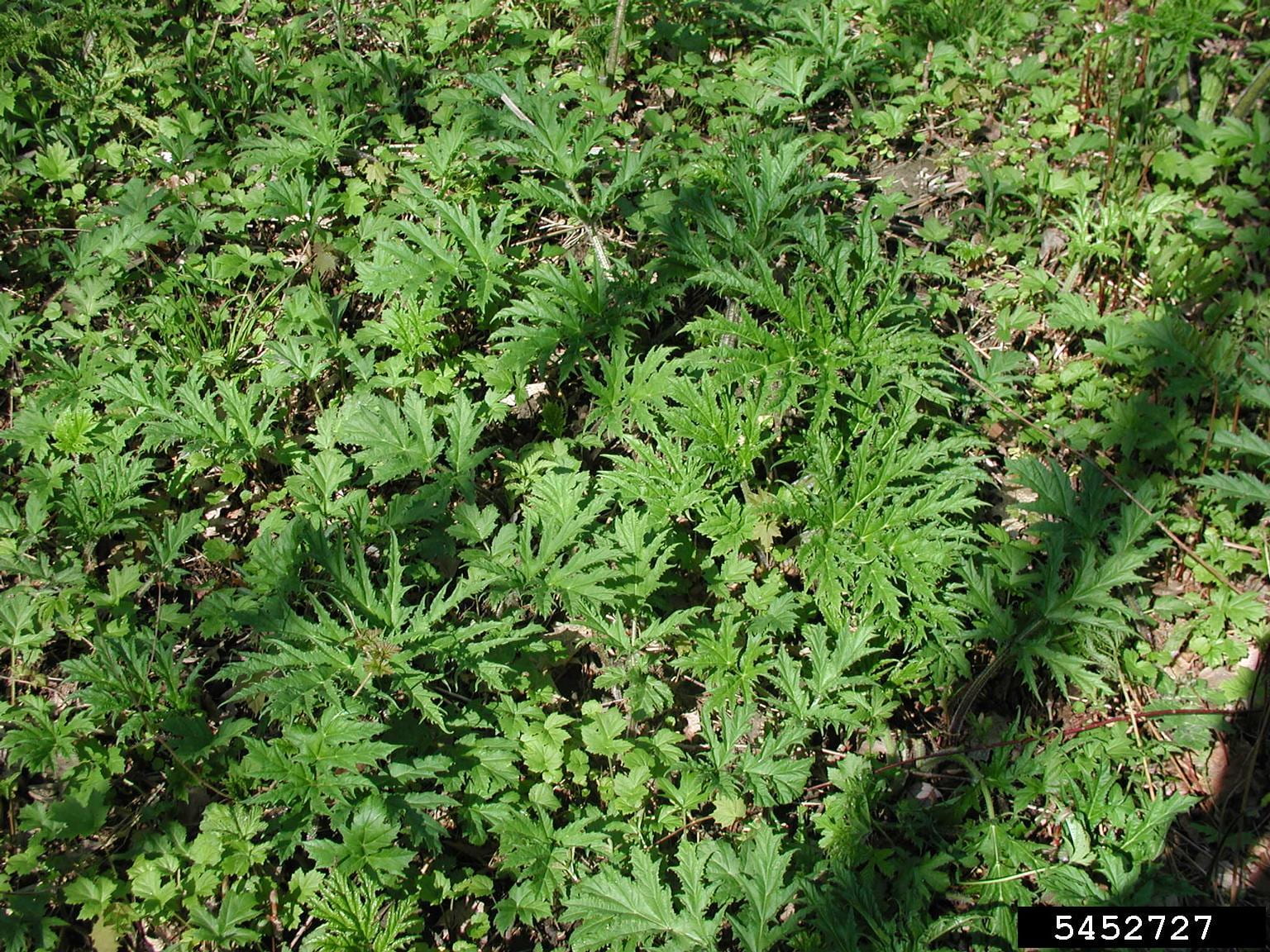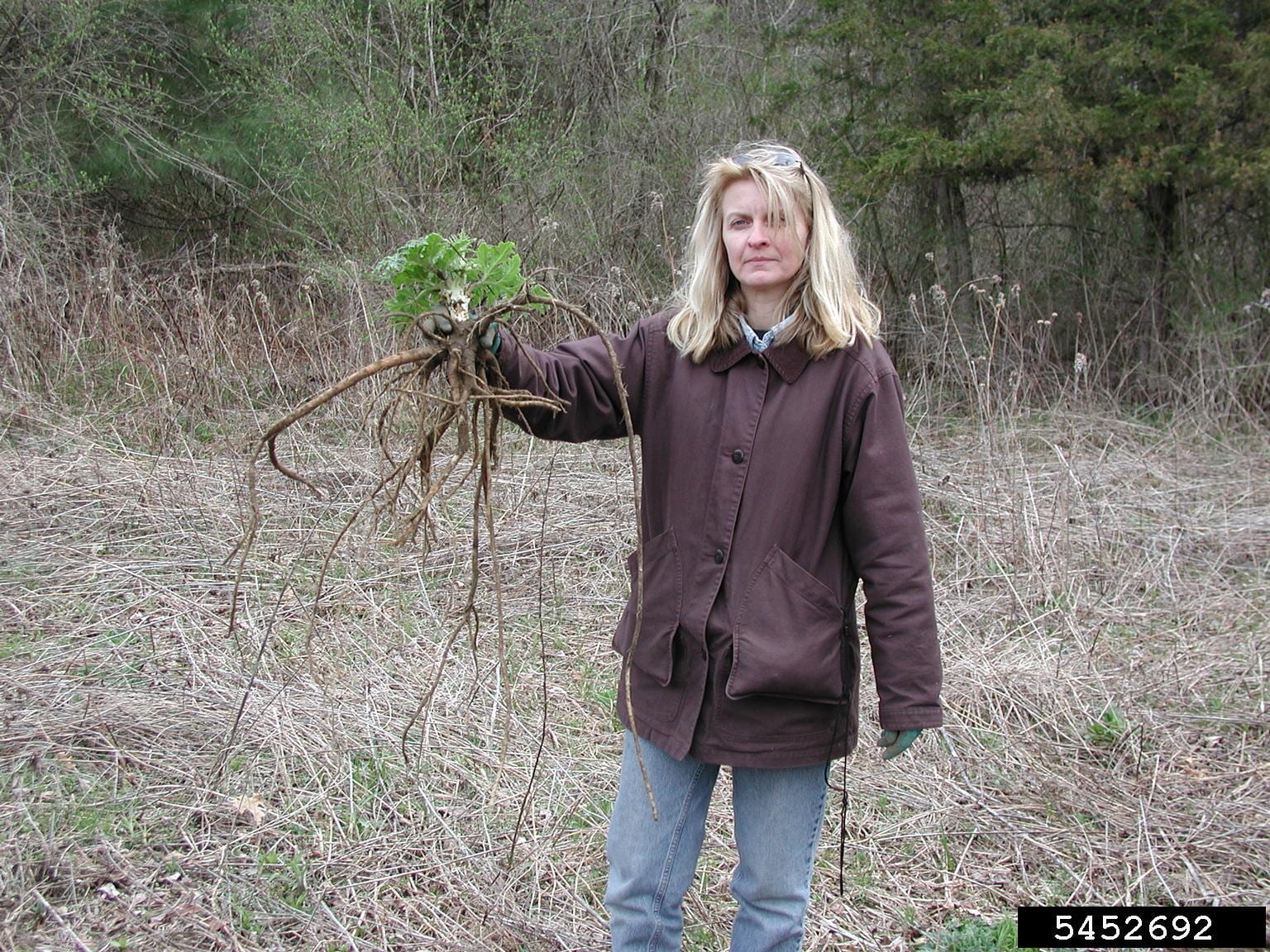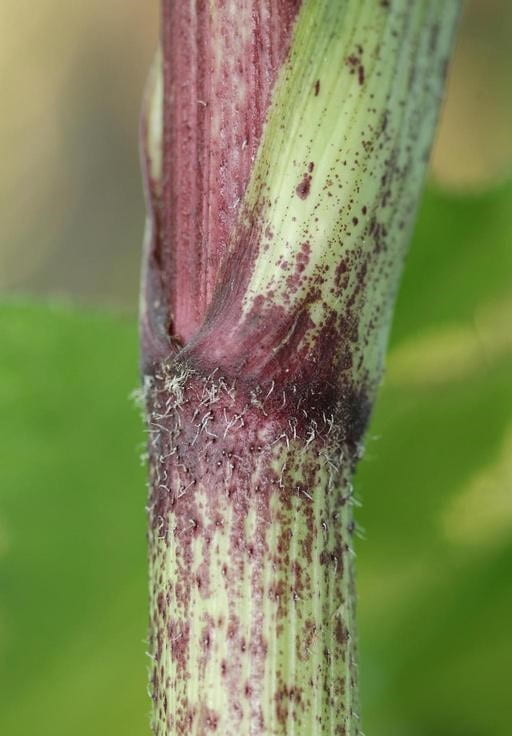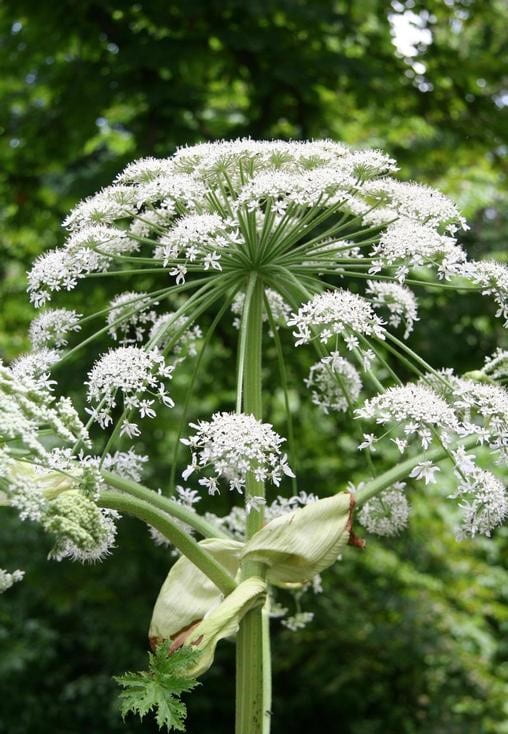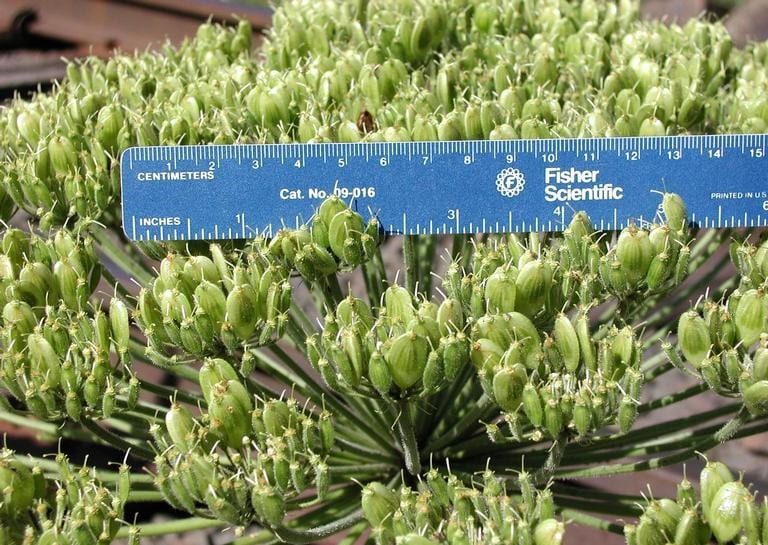Giant hogweed (Heracleum mantegazzianum) is arguably the most dangerous invasive plant in New York State, as a a significant threat to both human and environmental health. Exposure to the sap can cause serious burns for humans and livestock, and giant hogweed also has the capacity to invade natural and disturbed habitats. It prefers moist soils and partial shade, making riparian (stream bank) areas especially vulnerable to infestations. These plants crowd out native plants, which can contribute to streambank erosion. This herbaceous plant has been found throughout the state.
Giant hogweed is aggressively managed by the NYS Department of Environmental Conservation (NYSDEC) due to the severity of its impacts. Due to this intense management and monitoring, giant hogweed populations in New York are extensively mapped. If you think you have found giant hogweed on your property, report the infestation to the NYSDEC. Please see NYSDEC’s page on giant hogweed for more information on the Giant Hogweed Control Program and where to report sightings.
Toxicity
When exposed to skin, giant hogweed sap causes phytophotodermatitis, a chemical burn from increased sensitivity to sunlight. The compound causing it in the sap, furanocoumarin, is produced within all the aboveground plant parts including seedlings, leaves, stems, flowers, and fruits. Furanocoumarin makes the skin extremely sensitive to ultraviolet light. If the affected area is exposed to sunlight, the incresaed sensitivity can cause severe burns, blistering, painful sores, and purplish/blackish scars. Symptoms begin between one to three days after exposure, including redness, itching, burn-like lesions, and blistering. These reactions subside within a few days, but impacted areas can remain sensitive to light for several years, resulting in the reemergence of burns, lesions, and blisters. Hyperpigmentation, or darkening of the skin, can cause dark blackish or purplish scars. If sap gets in the eyes, it may cause temporary to permanent blindness.
If exposed to giant hogweed sap, immediately wash the area with water and soap, and protect the area from sunlight. If irritation begins to appear, medical advice should be sought immediately; in some cases, hospitalization may be required. Make sure to cover exposed areas with sunscreen and clothing when going outside, to prevent re-injury.
Because giant hogweed grows in a wide range of habitats, it’s a good idea to know how to identify it. Mature plants are very distinctive, but seedlings may be easier to overlook. There have been reports of people walking in bare feet being exposed to sap from seedlings. Giant hogweed’s large size when mature makes it attractive to children, who have been known to pick it and use the stems as swords or telescopes. If giant hogweed has been found in your area, educate those around you, especially children, on identification and avoidance of the plant. Although giant hogweed is palatable to cattle, sheep, and pigs, there are reports of farmers being exposed to sap by touching animals with sap on their bodies. If you find a new population of giant hogweed, please contact NYSDEC’s Giant Hogweed Control Program for free removal by professionals.

Giant hogweed burns. Image by USDA APHIS PPQ – Oxford, North Carolina, USDA APHIS PPQ via Bugwood.org
Identification
Seedlings: Giant hogweed emerges in early spring in a rosette pattern from seeds or tuberous root stalks. Young seedlings are toothed and slightly lobed. As the plants mature, leaves become more deeply lobed. Seedlings generally have a more glossy-looking texture compared to some of giant hogweed’s look-alike species.
Leaves: Giant hogweed leaves vary significantly in shape and size as the plant matures. Early leaves are deeply lobed into three sections. As the plant matures, leaves become deeply lobed and incised (note this difference in the pictures to the right between leaf on young plant vs leaf on mature plant). Leaves on giant hogweed are alternately arranged on the stem. Mature leaves can grow up to 5 feet (1.5 m) wide. Upper stem leaves are narrower and more triangular, but remain deeply cut and lobed.
Mature plant: Giant hogweed is a biannual or short-lived perennial, forming a rosette in its first year(s) and flowering the following year. In the first year, the plant only produces leaves and dedicates most of its energy to belowground growth. Once the root system is adequately established, giant hogweed will flower the next growing season. In moist soils where giant hogweed thrives best, the rosette stage only lasts one season and will flower the next like typical biennial plants. However, in less ideal sites, the plant may not flower for as many as 5 growing seasons.
At maturity, giant hogweed reaches 15 feet (4.5 m). The ridged, hollow stems of giant hogweed are 2 – 4 inches (5 – 10 cm) across. The stem is mostly green with purple blotches throughout. At the nodes and bases of petioles, the plant has a cluster of short, white hairs.
Flower/seeds: Giant hogweed flowers in late June to early July. Flowers are arranged in a compound umbrella shape made up of thousands of small, white flowers that can measure a whopping 2.5 feet (0.7 m) in diameter. Seeds are flat-oval shaped, winged, and green to dark brown. They spread through wind and water, especially in floodplains, and can last in the soil for up to 10 years. The plant dies after setting seed; the dried stalks remain through the winter.
Species Similar to Giant Hogweed
Table 1: Shows giant hogweed (Heracleum mantegazzianum) similarities and differences in identification compared to its similar species .| Species | Similarities | Differences |
|---|---|---|
| Cow parsnip (Heracleum maximum) | white flowers in clusters, broad leaves, hairy stems | no purple splotches on stems, 30 or less rays per flower cluster |
| Wild celery (Vallisneria americana) | compound leaves | completely purple stems, green flowers, rounded clusters, hairless stems |
| Queen Anne's lace/Wild carrot (Daucus carota) | white, flat-topped flowers in clusters; hairy stems | pinnate leaves, no purple splotches on stems |
| Poison hemlock (Conium maculatum) | white in clusters, flat-topped flowers; purple splotches on stems | hairless stems |
| Wild parsnip (Pastinaca sativa) | flat-topped flowers in clusters | yellow flowers, hairless stems, no purple splotches on stems, pinnate leaves |
| Wild lettuce (Lactuca virosa) | purple splotches on stem | yellow flowers, leaves are not broad |
| Valerian (Valeriana officinalis) | white flowers in clusters, compound leaves | leaves are not broad |
| Elderberry (Sambucus canadensis) | white, flat-topped flowers in clusters | silvery to yellow-gray hairless stems, unlobed leaves |
| Spotted water hemlock (Cicuta maculata) | white flowers in clusters, alternate leaves | smooth stems, toothed leaf margins |
Management
Chemical control
Chemical management for this plant is critical due to the threat it poses to human health. Herbicides are especially important for use in large infestations of giant hogweed. In addition to more traditional foliar applications, herbicides can be injected into stems. Areas must be monitored for at least three years after treatment to ensure giant hogweed is eradicated from the site.
The King County Noxious Weed Control Program and the New York Sea Grant provide specific management recommendations for both chemical and non-chemical control.
Non-chemical control
The most effective means of non-chemical control is monitoring for the establishment of new giant hogweed populations to enable early detection and rapid response to infestations. Giant hogweed can be removed manually, but adequate personal protective equipment must be worn. Young plants can be pulled readily before the taproot develops. For more mature plants, it’s best to cut the stem of the plant at the base and use shovels to dig out the root system. Giant hogweed is capable of resprouting from rootstock. Make sure all removed giant hogweed is disposed of properly, ensuring it cannot spread and isn’t left where someone may come in contact with it. Areas must be monitored for at least three years after treatment to ensure giant hogweed is eradicated from the site. Mechanical control is generally not recommended for this plant, due to the potential for the sap to spray when mowed or weed-whacked. Cutting stems can also stimulate budding on rootstalks, and the plant can resprout and flower within the same growing season.
The King County Noxious Weed Control Program and the New York Sea Grant provide management recommendations for both chemical and non-chemical control.
References
Cornell University Turfgrass and Landscape Weed ID- Weeds and Human Health: The Severe Seven http://turfweeds.cals.cornell.edu/weeds-and-human-health
Cornell University’s Weed Ecology and Management website. Contains a wealth of information on ecological management of agricultural and garden weeds. Look for a revamp of this site in 2021.
King County Noxious Weed Control Program, Bet Management Practices- Giant hogweed https://your.kingcounty.gov/dnrp/library/water-and-land/weeds/BMPs/hogweed-control.pdf
NYS Department of Environmental Conservation, Giant Hogweed https://www.dec.ny.gov/animals/39809.html#Identify
New York Sea Grant (NYSG) Invasive Species Factsheet Series: 07-1 Giant Hogweed (Heracleum mantegazzianum) – Poisonous Invader of the Northeast by Charles R. O’Neil, Jr. http://www.nyis.info/wp-content/uploads/files/Giant_Hogweed_FS_Print_Rev081009.pdf
Ohioline, Ohio State University Extension- Giant Hogweed (Heracleum mantegazzianum) by David L. Marrison and David J. Goerig https://ohioline.osu.edu/factsheet/anr-35



